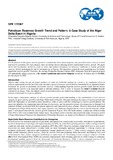| dc.contributor.author | Apara, Chiamaka | |
| dc.date.accessioned | 2017-05-22T13:22:49Z | |
| dc.date.available | 2017-05-22T13:22:49Z | |
| dc.date.issued | 2014-08-05 | |
| dc.identifier.citation | SPE 172367 | en_US |
| dc.identifier.uri | http://repository.aust.edu.ng:8080/xmlui/handle/123456789/585 | |
| dc.description.abstract | For the purpose of this paper, reserves growth is classified into three main categories: new pool discoveries, reserves revision and reserves extension. For each category, there are distinct factors affecting positive and residual reserves growth. The paper shows that fiscal/policy incentives, crude oil price and modern technology are necessary conditions to expand petroleum reserves, thereby prolonging the end of petroleum era in Nigeria. The deepwater remain the most promising area for further significant reserves growth. Therefore, the existing Production Sharing Contract (PSC) deepwater field development projects will undoubtedly impact positively to the country’s production and reserves blueprint toward the 40 billion and 4.0 MMBBL
per day targets by 2020. | en_US |
| dc.description.sponsorship | AUST | en_US |
| dc.language.iso | en | en_US |
| dc.publisher | Society of Petroleum Engineers (SPE) | en_US |
| dc.relation.ispartofseries | ;172367 | |
| dc.subject | 2014 Petroleum Engineering Publication | en_US |
| dc.subject | Chiamaka Kingsley Apara | en_US |
| dc.subject | Prof. Omowunmi Illedare | en_US |
| dc.subject | Petroleum reserves growth | en_US |
| dc.title | Petroleum Reserves Growth Trend and Pattern: A Case Study of the Niger Delta Basin in Nigeria | en_US |
| dc.type | Article | en_US |

